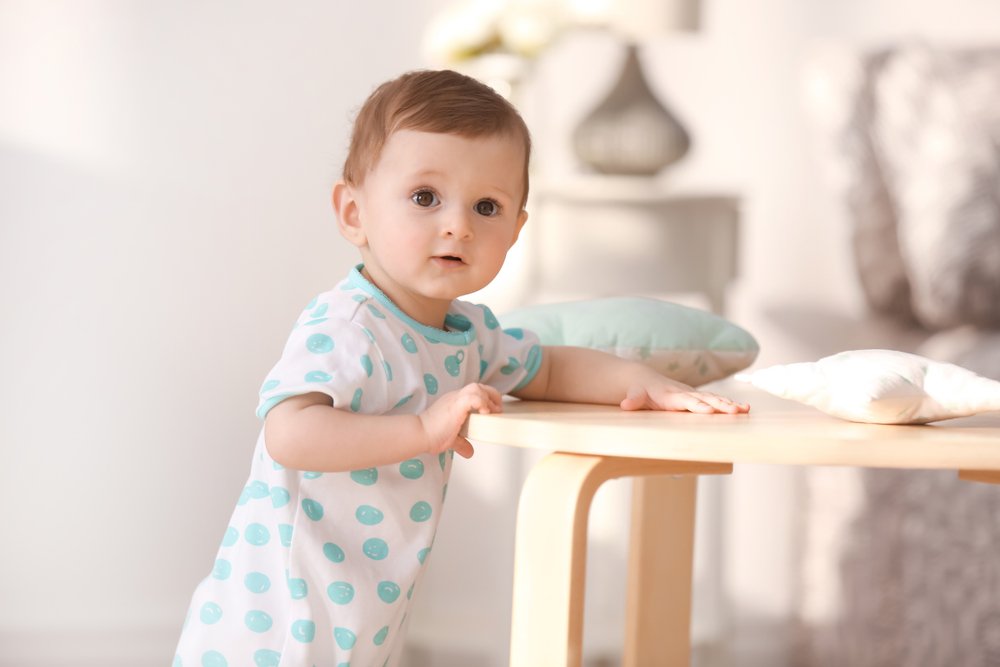Key points:
1. Your baby can stand while holding onto objects between 10-12 months.
2. They’ll briefly stand with your help, enhancing balance skills.
3. Around 11 months, they may transition from standing to sitting without help.
4. Ensure a safe environment for them to practice these skills, a step toward walking.
In Part 1 of this article, we discussed some of the first milestones your little one will accomplish. Now, we’ll give you a small insight into what you might notice when they are between 10 and 12 months old. Let’s discuss what comes next in the journey of your baby standing up!
Baby is standing up while holding on to something
We previously talked about how your little one will start pulling themselves up when holding on to furniture. At first, they might do it and then fall immediately back down. But soon enough, you’ll be lucky enough to witness how they keep a standing position while holding on to something.
This is a major step in the acquisition of this skill. They are exploring what it feels like to have their feet on the floor and carry their weight on their tiny legs. While they do this, they are also practicing their balance and proprioception skills. Keep a safe environment for them to feel confident enough to try their new moves and let them do it by themselves; even though you’ll be right next to them, try not to interfere.
This skill might emerge at around 10 months and, before you know it, they will be moving and cruising around while holding on to things, getting closer and closer to taking their first steps.
Stands momentarily with help
This skill is very related to the previous one and will also appear around 10 months of age, but instead of them holding on to an object, your child will hold your hand for support. This is a beautiful moment and an excellent chance to start working on tiny transitions towards standing independently. Your support will play a very important part in this process.
When you hold their hand, they feel safe; and since they are now holding on to something that moves, it is harder to keep the position. This is a great opportunity to practice balance together.
Hold their hand gently and pull them to a standing position. You can repeat this exercise many times and, as time goes by, try to gently start letting go. This way they’ll improve their balance and, one day, when you take your hand away, they will keep their balance all by themselves. Later on, you can also move forward when holding their hand to see if they take a step.
When a baby is standing up with help, they are also strengthening their leg and core muscles, stretching their hips, and getting used to putting weight on their feet. It’s a big step!
Goes from standing to sitting without your help
In Part 1 of this article, we’ve discussed the importance of going from sitting to a kneeling position. Now, we’ll address something that comes around a little bit later, at around 11 months of age: going from standing to sitting without help!
This is a milestone your little one will accomplish once their muscles are stronger since it needs more balance and coordination than the previous ones. They will probably start by pulling themselves up, keeping this position, and then bend their knees slowly until they reach a sitting position.
It seems easy, but to be able to move from a standing position to sitting down, balance skills have to be more advanced and your child must’ve developed enough spatial awareness to calculate where they’ll land.
While doing this, they are also exploring their new moves. A little bit later, they’ll start taking sliding steps while holding on to whatever is around for support and then sit down to play on the floor. Make sure that when they are at this stage, the objects around them are stable enough for them to put their weight on them without falling over. This milestone will allow them to move around and get objects from faraway places, a great precursor for walking. At around 13 months of age, they might be able to do it the other way around and accomplish going from a sitting to a standing position, which requires a little bit more strength and balance.
At this stage, your toddler is experimenting with balance every day. At first, they will need to hold on to something, either furniture, objects, or your loving hand. But in the blink of an eye, they will be able to hold a standing position by themselves. Witnessing this amazing milestone will be very rewarding! Be sure to keep your arms ready in case you need to catch them and prevent a fall.








